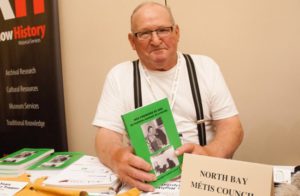True stories from a Métis Trapper

By Kelly Anne Smith
STURGEON FALLS— An autobiography called “My First Sixty Years Enjoying Nature as a Trapper”, is flying off of the shelves in the local Canadian Tire.
Alcide Giroux, also known as Lou or Ti-Lou to close friends, calls himself a funny trapper. He has written about his interesting life, first managing his own trap line in 1965. He still cherishes the start of each new trapping season.
His father was French and Algonquin, a heritage Giroux is proud of. “I try to maintain the traditions of my ancestors and live a life worthy of their teachings.” He also wrote that his dad was a “keen trapper with a built in GPS.”
The book highlights the author’s strong work ethic. “I never believed in waiting; get the job done and play after. We got it done and brought the moose out…”
As a fur harvester and an educator of wildlife management, Giroux has taught many youth about respect for animals and the importance of protecting their habitats. From the book’s Introduction, he opens up by stating that “people should know that we, trappers, are stewards of the land.”
Giroux was involved in a fur trade research committee in the 1980’s. “Then we organized the Fur Institute of Canada. I was a very active member on the Humane Trap Research and Development Committee for years and years.
My contribution was my experience and how to utilize a trap wisely. Will a trap harvest, will it be efficient and will it be humane?”
In 1997, Canada, Russia, and the European Union signed an Agreement on International Humane Trapping Standards, setting out trap performance requirements for 19 wild animal species – twelve that are from Canada.
Giroux travelled far and wide to give seminars to Canadian trappers, mainly First Nations on the new humane traps. Giroux went to the Arctic Ocean and the Louisiana swamps and even Paris, France. “We travelled Northern Saskatchewan up to La Ronge, Anzac, and up with the Inuit in the Beaufort Sea. Prior to that, I did a lot of work in Hudson’s Bay and James Bay. I travelled to every little town along the way.”
The trapper explains he enjoy natures. “We don’t just go kill, we harvest. We only take so many. We allow room for the others to produce. “
He points to beavers as an example. “If we didn’t control the beavers, we would be in trouble. Therefore, we establish reasonable quotas which we harvest every year. By law, once a quota has been established, we must produce 75%. It’s like a farmer on the farm. He loves animals, but once a year he has to kill animals.”
Giroux values his time in a canoe harvesting minnows. “I enjoy so much the water and the ponds. I observe everything. Right now I’m trapping minnows in a beautiful area that no one ever sees but me.”
Giroux is concerned with environmental changes. “We have to be careful about what is happening in the field. There have been so many dry ponds. Many areas have turned to grassy areas. We need lots of rain and cooler temperatures to re-establish the marshes and swamps. We have lost 20% or more of very productive marshes and ponds. They are gone from the Nipissing and Sudbury Districts.”
At the back of the book, Giroux shares his earned wisdom with tips such as never trust the ice. He has also included his traditional recipes.
The book about “the true life of a Métis trapper, his love for the land, his family, and his friends” is available in both English and French. It’s at Billy Bob’s and the Fur Harvesters in North Bay and in Sturgeon Falls at the Tribune and Canadian Tire. “They do very well. They sell my worms and minnows so in the same area they have a nice poster and my book. They are available at Al’s Live Bait too.”


